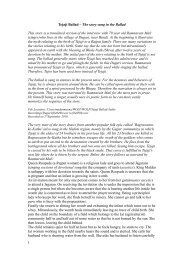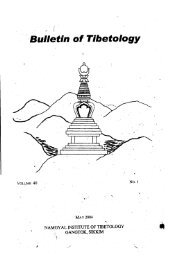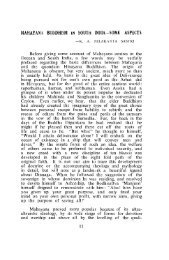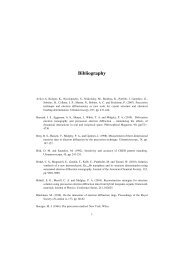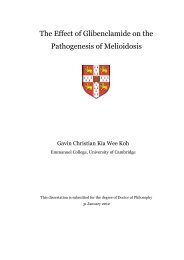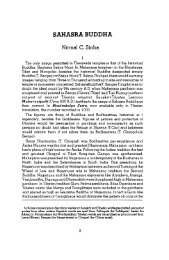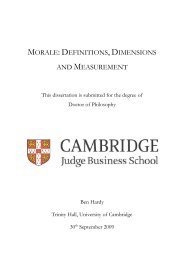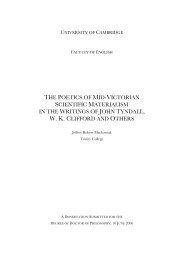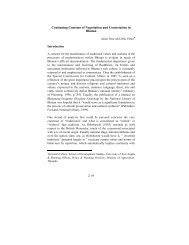The Crusades, the Genoese and the Latin East - DSpace at ...
The Crusades, the Genoese and the Latin East - DSpace at ...
The Crusades, the Genoese and the Latin East - DSpace at ...
You also want an ePaper? Increase the reach of your titles
YUMPU automatically turns print PDFs into web optimized ePapers that Google loves.
two levels. On <strong>the</strong> one h<strong>and</strong>, merchants <strong>and</strong> politicians sought new markets for <strong>Genoese</strong><br />
commerce. On <strong>the</strong> o<strong>the</strong>r h<strong>and</strong>, individual <strong>Genoese</strong> led priv<strong>at</strong>e enterprises to conquer l<strong>and</strong>s <strong>and</strong><br />
inevitably engage in b<strong>at</strong>tle with Venice <strong>and</strong> Pisa. In <strong>the</strong> light of this new era, <strong>the</strong> activities of<br />
some of <strong>the</strong> famous pir<strong>at</strong>es should be studied.<br />
<strong>The</strong> final years of <strong>the</strong> twelfth century <strong>and</strong> <strong>the</strong> beginning of <strong>the</strong> thirteenth century were<br />
years in which powerful individuals oper<strong>at</strong>ed in Genoa. Many of <strong>the</strong>m played a crucial role<br />
during this period. <strong>The</strong> activities of Guglielmo Embriaco maior as consul of Genoa who imposed<br />
his authority in Genoa during his consul<strong>at</strong>e in 1201 may be seen as part of <strong>the</strong> same p<strong>at</strong>tern.<br />
Much has been written about famous <strong>and</strong> infamous pir<strong>at</strong>es such as Guglielmo Grasso <strong>and</strong> his<br />
rel<strong>at</strong>ive Count Henry of Malta <strong>and</strong> Count Alamanno de Costa of Syracuse. 232 <strong>The</strong> commune's<br />
territorial, expansion <strong>and</strong> priv<strong>at</strong>e enterprise were linked to <strong>the</strong>ir activities too. Steven Epstein<br />
noted about <strong>the</strong> role of individual <strong>Genoese</strong> <strong>and</strong> <strong>the</strong> expansion of Genoa during this period th<strong>at</strong><br />
`enterprising <strong>Genoese</strong> had been acquiring possessions in <strong>the</strong> Mediterranean since <strong>the</strong> time of <strong>the</strong><br />
First Crusade, <strong>and</strong> by now <strong>the</strong> p<strong>at</strong>tern was well established th<strong>at</strong> <strong>the</strong> commune would not directly<br />
rule in <strong>the</strong>se places. '233 Charles Dalli argued in his <strong>the</strong>sis about Malta <strong>and</strong> <strong>the</strong> Regno th<strong>at</strong> `in <strong>the</strong><br />
Sicilian case str<strong>at</strong>egic consider<strong>at</strong>ions were paramount for <strong>Genoese</strong> commerce in Syria, as was <strong>the</strong><br />
Pisan base <strong>at</strong> Syracuse. Similarly, <strong>Genoese</strong> feudal control over Malta through <strong>Genoese</strong> Counts<br />
who were Sicilian vassals formed part of th<strong>at</strong> commune's wider str<strong>at</strong>egy of protecting <strong>Genoese</strong><br />
shipping from corsairs who built <strong>the</strong>ir nests <strong>at</strong> various points on <strong>the</strong> Mediterranean coast,<br />
including Malta itself, to oper<strong>at</strong>e along <strong>the</strong> Levantine trade routes. '234<br />
Syracuse in Sicily <strong>and</strong> <strong>the</strong> isl<strong>and</strong> of Malta were only first destin<strong>at</strong>ions for <strong>the</strong> count of<br />
Malta `et amicissimi sui comitis Alamanni [de Costa]. '235 <strong>The</strong>ir ambitions were almost<br />
unrestrained <strong>and</strong> <strong>the</strong>ir presence was soon felt throughout <strong>the</strong> central <strong>and</strong> eastern Mediterranean.<br />
Shortly after <strong>the</strong> conquest of Constantinople, <strong>the</strong>y engaged in war with <strong>the</strong> Venetians. <strong>The</strong><br />
confront<strong>at</strong>ion was h<strong>and</strong>led mainly though acts of piracy, but within a short span it was also<br />
transformed into an open conflict. One of <strong>the</strong> leading issues in this conflict was <strong>the</strong> isl<strong>and</strong> of<br />
Crete. It was ano<strong>the</strong>r consequence of <strong>the</strong> Fourth Crusade because in 1204 <strong>the</strong> isl<strong>and</strong> was awarded<br />
to Boniface of Montferr<strong>at</strong>. He sold <strong>the</strong> isl<strong>and</strong> to <strong>the</strong> Venetians for 1000 silver marks. David<br />
232<br />
See David Abulafia, `Henry of Malta'. More recent works concerning piracy, such as Mark Aloisio's<br />
<strong>the</strong>sis in progress on Maltese corsairs <strong>and</strong> Emily Tai <strong>the</strong>sis on Piracy in <strong>the</strong> Mediterranean in <strong>the</strong> fifteenth<br />
century <strong>and</strong> Charles Dalli, Malta in <strong>the</strong> Regno, Political, Social <strong>and</strong> Economic Developments in <strong>the</strong><br />
Maltese Isl<strong>and</strong>s in a Central Mediterranean Context, 1240-1500, unpublished master's <strong>the</strong>sis (University<br />
of Cambridge, 1992).<br />
233<br />
Steven Epstein, Genoa <strong>and</strong> <strong>the</strong> <strong>Genoese</strong>, 958-1528 (Chapel Hill, 1996), p. 103.<br />
234<br />
Charles Dalli, Malta in <strong>the</strong> Regno, p. 30.<br />
235<br />
Ann. Ian., vol. 2, p. 97.<br />
75



